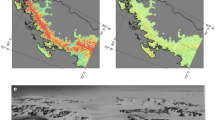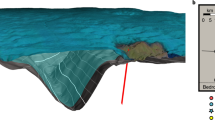Abstract
Antarctica preserves Earth’s largest ice-sheet, which in response to climate warming, may lose ice mass and raise sea level by several metres. The ice-sheet bed exerts critical controls on dynamic mass loss through feedbacks between water and heat fluxes, topographic forcing, till deformation and basal sliding. Here we show that sedimentary basins may amplify critical feedbacks that are known to impact ice-sheet retreat dynamics. We create a high-resolution subglacial geology classification for Antarctica by applying a supervised machine-learning method to geophysical data, revealing the distribution of sedimentary basins. Hydro-mechanical numerical modelling demonstrates that during glacial retreat, where sedimentary basins exist, the groundwater discharge rate scales with the rate of ice unloading. Antarctica’s most dynamic ice streams, including Thwaites and Pine Island glaciers, possess sedimentary basins in their upper catchments. Enhanced groundwater discharge and its associated feedbacks are likely to amplify basal sliding and increase the vulnerability of these catchments to rapid ice retreat and enhanced dynamic mass loss.
This is a preview of subscription content, access via your institution
Access options
Access Nature and 54 other Nature Portfolio journals
Get Nature+, our best-value online-access subscription
$29.99 / 30 days
cancel any time
Subscribe to this journal
Receive 12 print issues and online access
$259.00 per year
only $21.58 per issue
Buy this article
- Purchase on Springer Link
- Instant access to full article PDF
Prices may be subject to local taxes which are calculated during checkout




Similar content being viewed by others
Data availability
The results of RF classification and hydro-mechanical modelling can be accessed at https://doi.org/10.5281/zenodo.6611940.
Code availability
The R notebook for RF classification can be accessed at https://doi.org/10.5281/zenodo.6611940. The code of CVEFM_Rift2D can be accessed in the supplementary material from the original paper32.
References
Dutton, A. et al. Sea-level rise due to polar ice-sheet mass loss during past warm periods. Science 349, aaa4019 (2015).
DeConto, R. M. & Pollard, D. Contribution of Antarctica to past and future sea-level rise. Nature 531, 591–597 (2016).
Rignot, E. et al. Four decades of Antarctic ice sheet mass balance from 1979–2017. Proc. Nat. Acad. Sci. USA 116, 1095–1103 (2019).
Edwards, T. L. et al. Projected land ice contributions to twenty-first-century sea level rise. Nature 593, 74–82 (2021).
Seroussi, H. et al. ISMIP6 Antarctica: a multi-model ensemble of the Antarctic ice sheet evolution over the 21st century. Cryosphere 14, 3033–3070 (2020).
Noble, T. L. et al. The sensitivity of the Antarctic ice sheet to a changing climate: past, present, and future. Rev. Geophys. https://doi.org/10.1029/2019RG000663 (2020).
Koellner, S., Parizek, B. R., Alley, R. B., Muto, A. & Holschuh, N. The impact of spatially-variable basal properties on outlet glacier flow. Earth Planet. Sci. Lett. 515, 200–208 (2019).
Bougamont, M. et al. Reactivation of Kamb Ice Stream tributaries triggers century‐scale reorganization of Siple Coast ice flow in West Antarctica. Geophys. Res. Lett. 42, 8471–8480 (2015).
Krabbendam, M. & Glasser, N. F. Glacial erosion and bedrock properties in NW Scotland: abrasion and plucking, hardness and joint spacing. Geomorphology 130, 374–383 (2011).
Breiman, L. Random forest. Mach. Learn. 45, 5–32 (2001).
Kuhn, S., Cracknell, M. J. & Reading, A. M. Lithological mapping in the Central African Copper Belt using random forests and clustering: strategies for optimised results. Ore Geol. Rev. 112, 103015 (2019).
Morlighem, M. et al. Deep glacial troughs and stabilizing ridges unveiled beneath the margins of the Antarctic ice sheet. Nat. Geosci. 13, 132–137 (2020).
Scheinert, M. et al. New Antarctic gravity anomaly grid for enhanced geodetic and geophysical studies in Antarctica. Geophys. Res. Lett. 43, 600–610 (2016).
Golynsky, A. V. et al. New magnetic anomaly map of the Antarctic. Geophys. Res. Lett. 45, 6437–6449 (2018).
Aitken, A. R. et al. Repeated large-scale retreat and advance of Totten Glacier indicated by inland bed erosion. Nature 533, 385–389 (2016).
Ferraccioli, F. et al. East Antarctic rifting triggers uplift of the Gamburtsev Mountains. Nature 479, 388–392 (2011).
Evans, D., Phillips, E., Hiemstra, J. & Auton, C. Subglacial till: formation, sedimentary characteristics and classification. Earth Sci. Rev. 78, 115–176 (2006).
Alley, R. B., Blankenship, D. D., Bentley, C. R. & Rooney, S. Deformation of till beneath ice stream B, West Antarctica. Nature 322, 57–59 (1986).
Muto, A. et al. Relating bed character and subglacial morphology using seismic data from Thwaites Glacier, West Antarctica. Earth Planet. Sci. Lett. 507, 199–206 (2019).
Gowan, E. J., Niu, L., Knorr, G. & Lohmann, G. Geology datasets in North America, Greenland and surrounding areas for use with ice sheet models. Earth Syst. Sci. Data 11, 375–391 (2019).
Alley, R. B. et al. How glaciers entrain and transport basal sediment: physical constraints. Quat. Sci. Rev. 16, 1017–1038 (1997).
Bell, R. E. et al. Influence of subglacial geology on the onset of a West Antarctic ice stream from aerogeophysical observations. Nature 394, 58–62 (1998).
Bell, R. E. The role of subglacial water in ice-sheet mass balance. Nat. Geosci. 1, 297–304 (2008).
Dow, C. F. et al. Dynamics of active subglacial lakes in Recovery Ice Stream. J. Geophys. Res. Earth Surf. 123, 837–850 (2018).
Christoffersen, P. & Tulaczyk, S. Response of subglacial sediments to basal freeze‐on 1. Theory and comparison to observations from beneath the West Antarctic Ice Sheet. J. Geophys. Res. Solid Earth 108, 2222 (2003).
Gooch, B. T., Young, D. A. & Blankenship, D. D. Potential groundwater and heterogeneous heat source contributions to ice sheet dynamics in critical submarine basins of East Antarctica. Geochem. Geophys. Geosyst. 17, 395–409 (2016).
Siegert, M. J. et al. Antarctic subglacial groundwater: a concept paper on its measurement and potential influence on ice flow. Geol. Soc. Spec. Pub. 461, 197–213 (2018).
Bense, V. & Person, M. Transient hydrodynamics within intercratonic sedimentary basins during glacial cycles. J. Geophys. Res. Earth Surface 113, F04005 (2008).
Flowers, G. E. & Clarke, G. K. A multicomponent coupled model of glacier hydrology 1. Theory and synthetic examples. J. Geophys. Res. Solid Earth 107, 2287 (2002).
Boulton, G., Lunn, R., Vidstrand, P. & Zatsepin, S. Subglacial drainage by groundwater-channel coupling, and the origin of esker systems: part 1—glaciological observations. Quat. Sci. Rev. 26, 1067–1090 (2007).
Le Brocq, A. M. et al. Evidence from ice shelves for channelized meltwater flow beneath the Antarctic ice sheet. Nat. Geosci. 6, 945–948 (2013).
Zhang, Y. et al. Hydromechanical impacts of Pleistocene glaciations on pore fluid pressure evolution, rock failure, and brine migration within sedimentary basins and the crystalline basement. Water Resour. Res. 54, 7577–7602 (2018).
Konrad, H. et al. Net retreat of Antarctic glacier grounding lines. Nat. Geosci. 11, 258–262 (2018).
Pattyn, F. Antarctic subglacial conditions inferred from a hybrid ice sheet/ice stream model. Earth Planet. Sci. Lett. 295, 451–461 (2010).
Joughin, I. et al. Basal conditions for Pine Island and Thwaites Glaciers, West Antarctica, determined using satellite and airborne data. J. Glaciol. 55, 245–257 (2009).
Siegert, M. J. et al. Subglacial controls on the flow of Institute Ice Stream, West Antarctica. Ann. Glaciol. 57, 19–24 (2016).
Catania, G., Hulbe, C., Conway, H., Scambos, T. A. & Raymond, C. Variability in the mass flux of the Ross ice streams, West Antarctica, over the last millennium. J. Glaciol. 58, 741–752 (2012).
Golledge, N., Levy, R., McKay, R. & Naish, T. East Antarctic ice sheet most vulnerable to Weddell Sea warming. Geophys. Res. Lett. 44, 2343–2351 (2017).
DeConto, R. M. et al. The Paris Climate Agreement and future sea-level rise from Antarctica. Nature 593, 83–89 (2021).
Flament, T., Berthier, E. & Rémy, F. Cascading water underneath Wilkes Land, East Antarctic ice sheet, observed using altimetry and digital elevation models. Cryosphere 8, 673–687 (2014).
Christoffersen, P., Bougamont, M., Carter, S. P., Fricker, H. A. & Tulaczyk, S. Significant groundwater contribution to Antarctic ice streams hydrologic budget. Geophys. Res. Lett. 41, 2003–2010 (2014).
Schoof, C. Ice sheet grounding line dynamics: steady states, stability, and hysteresis. J. Geophys. Res. Earth Surf. 112, F03S28 (2007).
Schroeder, D. M., Blankenship, D. D. & Young, D. A. Evidence for a water system transition beneath Thwaites Glacier, West Antarctica. Proc. Nat. Acad. Sci. USA 110, 12225–12228 (2013).
Schroeder, D. M., Blankenship, D. D., Young, D. A., Witus, A. E. & Anderson, J. B. Airborne radar sounding evidence for deformable sediments and outcropping bedrock beneath Thwaites Glacier, West Antarctica. Geophys. Res. Lett. 41, 7200–7208 (2014).
Brisbourne, A. M. et al. Bed conditions of Pine Island Glacier, West Antarctica. J. Geophys. Res. Earth Surf. 122, 419–433 (2017).
Parizek, B. et al. Dynamic (in) stability of Thwaites Glacier, West Antarctica. J. Geophys. Res. Earth Surf. 118, 638–655 (2013).
Muto, A. et al. Subglacial bathymetry and sediment distribution beneath Pine Island Glacier ice shelf modeled using aerogravity and in situ geophysical data: new results. Earth Planet. Sci. Lett. 433, 63–75 (2016).
Rignot, E., Jacobs, S., Mouginot, J. & Scheuchl, B. Ice-shelf melting around Antarctica. Science 341, 266–270 (2013).
Wright, A. & Siegert, M. A fourth inventory of Antarctic subglacial lakes. Antarct. Sci. 24, 659 (2012).
Breiman, L., Friedman, J., Stone, C. J. & Olshen, R. A. Classification and Regression Trees (CRC Press, 1984).
Liaw, A. & Wiener, M. Classification and regression by randomForest. R News 2, 18–22 (2002).
Cracknell, M. J. & Reading, A. M. Geological mapping using remote sensing data: a comparison of five machine learning algorithms, their response to variations in the spatial distribution of training data and the use of explicit spatial information. Comput. Geosci. 63, 22–33 (2014).
Smith, B. et al. Pervasive ice sheet mass loss reflects competing ocean and atmosphere processes. Science 368, 1239–1242 (2020).
Mouginot, J., Rignot, E. & Scheuchl, B. Continent‐wide, interferometric SAR phase, mapping of Antarctic ice velocity. Geophys. Res. Lett. 46, 9710–9718 (2019).
Acknowledgements
We thank M. Morlighem for providing basal friction data. This research was supported by the Australian Research Council Special Research Initiative, Australian Centre for Excellence in Antarctic Science (project number SR200100008). L.L. was supported by China Scholarship Council–The University of Western Australia joint PhD scholarship (201806170054). M.D.L. was supported by ARC DECRA DE190100431 and ARC ITTC IC190100031. We thank M. Siegert for his constructive comments on an earlier version of the manuscript.
Author information
Authors and Affiliations
Contributions
L.L. led the research; L.L., A.R.A.A. and M.D.L. conceived the scope and design of the research. L.L. and A.R.A.A. led the writing of the manuscript. L.L., A.R.A.A. and B.K. discussed and wrote the ice-sheet dynamics section. M.D.L. and A.R.A.A. advised L.L. in performing random-forest classification. A.R.A.A. advised L.L. in performing hydro-mechanical modelling. All authors contributed to the writing of the manuscript.
Corresponding author
Ethics declarations
Competing interests
The authors declare no competing interests.
Peer review
Peer review information
Nature Geoscience thanks Calvin Shackleton and the other, anonymous, reviewer(s) for their contribution to the peer review of this work. Primary Handling Editor: Tom Richardson, in collaboration with the Nature Geoscience team.
Additional information
Publisher’s note Springer Nature remains neutral with regard to jurisdictional claims in published maps and institutional affiliations.
Extended data
Extended Data Fig. 1 Rate of grounding line migration rate versus rate of ice thinning.
The black dots show the estimated continental wide grounding line retreat rate versus ice thinning rate33. The blue crosses mark the grounding line retreat rate that we used in hydro-mechanical modelling. Detail of the estimation of grounding line migration and ice thinning rate are shown in Supplementary Information 2.1.2.
Supplementary information
Supplementary Information
Supplementary Sections 1 and 2.
Supplementary Video 1
Vertical water flux during the glacier cycle (base permeability caseː κz = 10−15 m2).
Supplementary Video 2
Vertical water flux during the glacier cycle (high permeability case: κz = 10−13 m2).
Rights and permissions
About this article
Cite this article
Li, L., Aitken, A.R.A., Lindsay, M.D. et al. Sedimentary basins reduce stability of Antarctic ice streams through groundwater feedbacks. Nat. Geosci. 15, 645–650 (2022). https://doi.org/10.1038/s41561-022-00992-5
Received:
Accepted:
Published:
Issue Date:
DOI: https://doi.org/10.1038/s41561-022-00992-5



